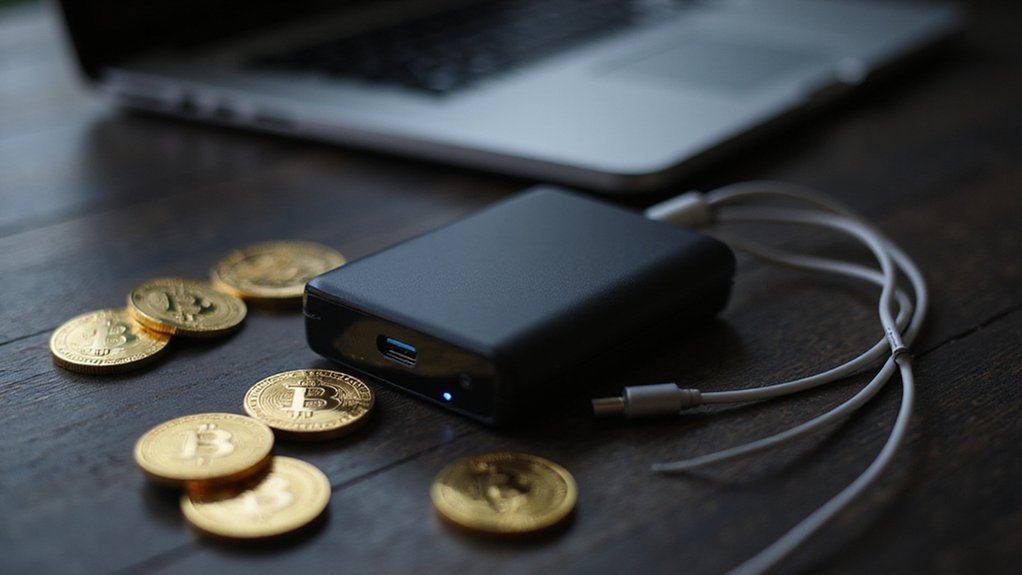A Bitcoin wallet operates as a cryptographic key management system rather than actual currency storage—because the Bitcoin itself remains perpetually recorded on the blockchain’s distributed ledger. These digital tools safeguard private keys (alphanumeric strings enabling transaction signatures) while generating corresponding public keys that create receiving addresses. Whether deployed as web-based, desktop, mobile, or hardware variants, wallets interface with the Bitcoin network to broadcast transactions and monitor blockchain activity, though the underlying mechanics reveal considerably more complexity.

A Bitcoin wallet, despite its name suggesting otherwise, stores no Bitcoin whatsoever—a curious nomenclature that has confused newcomers since the cryptocurrency’s inception.
Rather than holding digital currency, these applications and devices function as sophisticated key management systems, safeguarding the cryptographic private keys that grant access to Bitcoin addresses recorded immutably on the blockchain.
Bitcoin wallets are sophisticated key management systems rather than actual currency containers, safeguarding cryptographic access to blockchain-recorded addresses.
The wallet’s primary function involves managing these private keys—essentially long strings of alphanumeric characters that serve as digital signatures for transactions.
From these private keys, corresponding public keys are mathematically derived, creating Bitcoin addresses where others can send funds.
The wallet software then interfaces with the Bitcoin network, broadcasting signed transactions and monitoring blockchain activity for relevant updates.
Various wallet types cater to different security preferences and use cases.
Web wallets, typically operated by exchanges, offer convenience while requiring users to trust third parties with private key custody—a proposition that would make Satoshi Nakamoto weep.
Desktop and mobile wallets provide greater control, storing keys locally while maintaining internet connectivity for transaction broadcasting.
Hardware wallets, resembling USB drives, offer cold storage solutions by keeping private keys offline until transaction signing becomes necessary.
Security features distinguish professional-grade wallets from amateur implementations.
Encryption protects stored data, while two-factor authentication adds login barriers.
Multisignature functionality requires multiple private keys to authorize transactions, distributing risk across several parties or devices.
Regular software updates patch vulnerabilities that hackers continuously exploit.
Protecting wallet credentials through password managers helps ensure that account access remains secure while maintaining the complexity required for robust security.
The operational mechanics remain elegantly simple: users specify recipient addresses and amounts, wallet software constructs transactions using unspent outputs, private keys sign these transactions cryptographically, and the signed data broadcasts to network nodes for verification and inclusion in subsequent blocks.
Despite their advantages—convenience, flexibility, and alignment with Bitcoin’s decentralized ethos—wallets present significant risks.
Hot wallets connected to the internet face constant cyber threats, while private key loss results in permanent fund inaccessibility (no customer service exists for blockchain recovery).
The responsibility for secure key management falls entirely upon users, transforming every Bitcoin holder into their own bank—complete with all accompanying anxieties and potential catastrophes that such responsibility entails.
Users can stay informed about wallet security best practices and updates through various channels, including subscribing to newsletter updates from reputable cryptocurrency companies.
Modern wallets can accommodate multiple cryptocurrencies beyond Bitcoin, allowing users to manage diverse digital asset portfolios through a single interface.
Frequently Asked Questions
Can I Lose My Bitcoin if I Forget My Wallet Password?
Yes, forgetting a Bitcoin wallet password effectively locks one out of their funds permanently.
Unlike traditional banking systems with customer service representatives who can reset credentials, Bitcoin’s decentralized architecture offers no such safety net.
The wallet’s encryption renders contents inaccessible without the correct password.
While professional recovery services exist—employing sophisticated techniques for modest fees—success isn’t guaranteed, leaving many investors staring at their digital vault’s impenetrable door.
How Much Does It Cost to Create a Bitcoin Wallet?
Creating a Bitcoin wallet involves costs ranging from $8,000 for basic functionality to over $28,000 for sophisticated implementations featuring multi-currency support and hardware integration.
Development expenses fluctuate based on security requirements, platform preferences, and team location—because apparently geographic arbitrage extends to cryptocurrency development.
Advanced features like DeFi integration or staking capabilities push costs toward the upper threshold, while ongoing maintenance represents perpetual financial commitment beyond initial development investment.
Can I Use the Same Wallet for Other Cryptocurrencies Besides Bitcoin?
Most Bitcoin wallets support multiple cryptocurrencies, transforming into convenient multi-currency management platforms.
Each cryptocurrency requires separate private keys—Bitcoin keys won’t access Ethereum vaults, naturally—but modern wallets generate and store these distinct key sets seamlessly.
Users enjoy consolidated balance views and unified transaction histories across supported coins.
However, this convenience carries amplified risk: compromising one wallet potentially exposes multiple cryptocurrency holdings simultaneously, making provider reputation absolutely critical for security-conscious investors.
What Happens to My Bitcoin if the Wallet Company Goes Out of Business?
The outcome depends entirely on wallet type—a distinction that proves rather consequential.
With custodial wallets, users face the delightful prospect of joining bankruptcy proceedings as creditors, potentially losing everything amid automatic stays and clawback attempts.
Non-custodial wallets, however, present a different scenario: since users control their private keys independently, the company’s demise becomes merely inconvenient rather than catastrophic, requiring only migration to alternative wallet software.
How Do I Transfer Bitcoin From One Wallet to Another Wallet?
Transferring Bitcoin requires accessing the sending wallet, selecting the transfer option, and entering the recipient’s address—preferably via QR code to avoid costly typos.
After specifying the amount and reviewing network fees (which fluctuate with typical crypto unpredictability), one confirms the transaction.
The transfer then propagates across the blockchain, typically taking minutes to hours depending on fee generosity and network congestion, while both parties monitor confirmation status.









